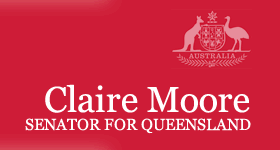Eye Health
Senator MOORE (Queensland) (1.39 pm)-On its website, the International Trachoma Initiative defines trachoma as a 'hidden disease'. Trachoma itself is caused by the bacterium Chlamydia trachomatis. It has been known about since ancient times; in fact, it is one of the oldest known infectious diseases. It virtually disappeared from the industrialised world in the last couple of decades, though it continues to plague the developing world. The World Health Organisation website outlines where trachoma continues to exist as a painful, devastating problem and it lists Latin America, parts of Africa-in particular, Niger-and Australia. To our shame, in 2007 Australia still has a disease on the international awareness program which is clearly defined as preventable. In late 1999 the World Health Organisation in conjunction with the International Agency for the Prevention of Blindness launched Vision 2020, a wonderful project which aims to wipe out preventable blindness and ensure eye health across the world.
Australia has a strong role to play in that program and we are beginning to do so. But, as has been said in this place this week by other senators, it is still to our shame. We are not looking at developing countries where this issue of trachoma continues to blind people; we are looking at it in our own country, Australia. The causes are not unknown; people understand the causes. What is unknown and what we still do not have in this country despite numerous reports is a clear snapshot of the number of people who are suffering from this disease. We also do not have a snapshot that identifies those who are potential sufferers of the disease so that these cases can be wiped out before they start. In July 2004, the Australian Health Ministers Conference agreed on the need to develop a national eye health plan for Australia to promote eye health and to reduce the incidence of avoidable blindness. This was, in part, our contribution and our commitment to the World Health Organisation's decision. In that process, a document was produced which sets out a strategic national framework for action for the promotion of eye health and the prevention of avoidable blindness. I say again: the prevention of avoidable blindness. This is to our shame; it is avoidable blindness. We have the ability, the knowledge and the strength to identify those people who have the potential to lose their sight so that this can be treated immediately and stopped, as has been done in many other countries. We have a growing awareness and level of commitment, and the state and federal governments have worked together to look at what is going on in our country. In the last 12 months, health management guidelines have been developed by the Communicable Diseases Network. Those guidelines have been agreed on and distributed, and funding has been offered to the three jurisdictions where trachoma occurs most in Australia. Unsurprisingly, those jurisdictions are South Australia, the Northern Territory and Western Australia. The members of our community who are at risk of losing their sight-or who far too often have already lost their sight-are our Aboriginal population. That has been known for generations. In 2007, we have on record that this is a major issue.
The government has developed a new National Trachoma Surveillance and Reporting Unit; it is welcomed. It is an organisation which must be continually funded and whose work must be supported. This is where we are able to take-and I say this with shame-our first tottering steps towards solving the problem. Those words sum it up: surveillance and reporting. We are able to look at what is going on, report on the incidence and then take action to ensure that people's sight is protected. The National Trachoma Surveillance and Reporting Unit has been established by the Centre for Eye Research Australia after a very competitive open tender process. It is in line with the Australian government's objective to improve the overall quality and consistency of data collection and reporting on trachoma in Australia.
We know that this is a problem and, as recently as 2006, there was a report put out called Prevalence and control of trachoma in Australia, 1997-2004. This document was released through the document Communicable diseases intelligence, volume 30 number 2: June 2006. The report was an academic surveillance of what was going on in our country in the period 1997 to 2004. It involved academic and professional consideration of the data that was already being collected across all states of Australia, how it was being collected and what was being done, and then what treatments were being put in place. It was, I think, an attempt to see exactly what the current statistics are in our country. Unsurprisingly, what came out of it was that there was no standard way of reporting on the incidence, and that we needed to have an agreed process for all the jurisdictions to ensure that their counts were being done in the same way and to ensure that people were involved in the process so that we did not lose people who should be part of any program. As a result of an effective data collection, we can effectively plan so that resources can be directed to the places where they are most needed.
We now have guidelines that have been developed and agreed-this is an evolving process that we now have a first round snapshot of the data from 2006-so we can effectively move forward with the focused treatment actions that need to take place. The focuses treatment actions are known. It is clear that this horrid disease, trachoma, is linked to a whole range of life issues so that, once again, we understand that disadvantage causes people to be unwell. Trachoma incidence is one that has been clearly defined-if there is an effective education program; if people understand what causes the condition; if people then amend behaviours so that, most particularly, there is cleanliness and effective health in the households, the schools and the communities-if those things are understood and then cooperatively entrenched in the communities, this preventable disease can, in Australia in 2007, be prevented. That does seem to me to be something that we should be able to commit to without any problem. Over a series of Senate estimates that I have been involved with in the last few years, and I know for many years before that, there have been consistent questions asked about the eye health of Indigenous people in Australia. Attempts to find out how the process is operating, where resources are being dedicated and also, in terms of outcomes, to find out the measurement to ensure that, when areas of need have been identified, that processes and ongoing monitoring are put in place so that initial treatment can be maintained into the future. This condition can come back. It is not enough just to do one intervention. Too often our health programs are focused around single interventions. It needs to be cooperatively agreed that this is a long-term dedicated and systematic process that involves working into the future, particularly when working with children. Recently we have heard a lot about health checks for children, and that is something that must be maintained and welcomed so that children have confidence in knowing that their health is being considered, that they have safety and that people care about their futures. Once interventions are put in place through the initial monitoring and testing that must be done, then at the local level with local people a longterm strategy is put in place to ensure that the health and security is maintained. Only then can we feel secure that people's eyesight and other things-but I am focusing on eyesight today-will be protected and maintained.
At what cost? How can you cost the aspect of someone's ability to see? When we see the impact of people who have lost their sight, we see the restriction of their life and the various things that they can no longer do, the impact on their livelihoods and their ability to communicate in their local area. All those things are impacted upon by their inability to see effectively. What is so worrying is that, in many Indigenous communities, it seems that the fact that people go blind is accepted as something that is quite normal. We should not be accepting that. The World Health Organisation has agreed that we have an international responsibility to ensure that people's eyesight be protected. We should have that same security in every community in our country-that it is not okay for people to accept that it is a natural thing for people to get sore eyes and go blind. I point out here that when we are talking about 'sore eyes'-and that is a direct quote from working with kids in remote locations-this condition, trachoma, and what comes beyond that is incredibly painful.
We have the immediacy of someone who is losing the ability to see, something that we treasure so strongly. Eyesight is something so natural that we cannot imagine not having that right. Not only is the eyesight restricted, which leads on to a whole lot of other issues about ability to learn, ability to be part of sporting teams and ability to live life to your fullest ability, which is one of our rights as citizens, but more so than that, there is incredible pain. I do not think that we should accept that, in 2007, in Australia a preventable disease such as trachoma should be able to be even acknowledged as being there, let alone being listed by the World Health Organisation as the only developed country where this condition is listed. We have the ability to collect data from participating state and territory jurisdictions consistent with the guidelines which have now been agreed. We can analyse and report on the trachoma prevalence and control activities within Australia, and then we can monitor the rates of antibiotic resistance to-I am going to have a go at this one-Azithromycin. It is the current best practice usage of the antibiotic readily available but, as with all things, we have to make sure that we monitor the usage of this to ensure that the strength is able to be retained. Once again, single interventions in long-term health plans do not work.
The only way that we will be able to achieve the goals, which we have set and agreed to, is to ensure that we are not looking at a one- or two-year plan. The World Health Organisation is aiming in Vision 2020 to have this particular round of preventable diseases wiped out across the world by 2020. We need to make the commitment for much longer than that. This comes back to the Close the Gap campaign, which we have talked about before in this place, which aims to close the gap on a whole range of health issues in the Indigenous communities within a 25-year span. It is only when we are able to work cooperatively, to engage together with communities and share our commitment and our strength, that we will be able to reach those goals.
When Close the Gap was launched, instead of just quoting statistics we were called to look beyond numbers to see faces and people. It is particularly important when we are looking at the issue of eyesight that we look at the faces and we see the joy when someone is able to see well and also the overwhelming joy where through an intervention, particularly through surgery, someone is able to regain the use of their eyes. We have a long way to go in our program. We have the ability to win this battle. When we come to the end of 2020, preventable blindness in this country must no longer happen. Trachoma should be retained always as a historical disease rather than one which is being faced by people in our community in 2007.




